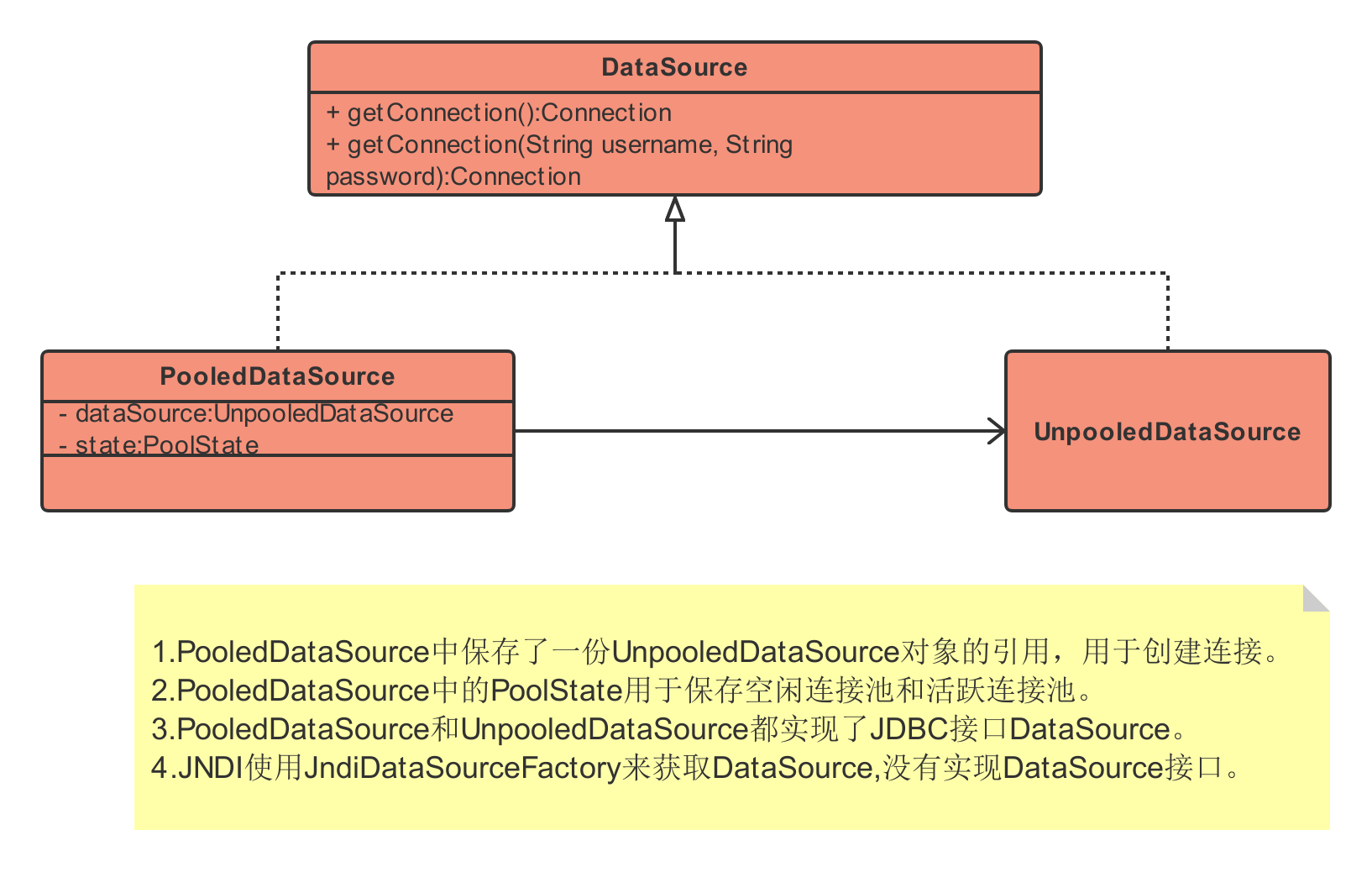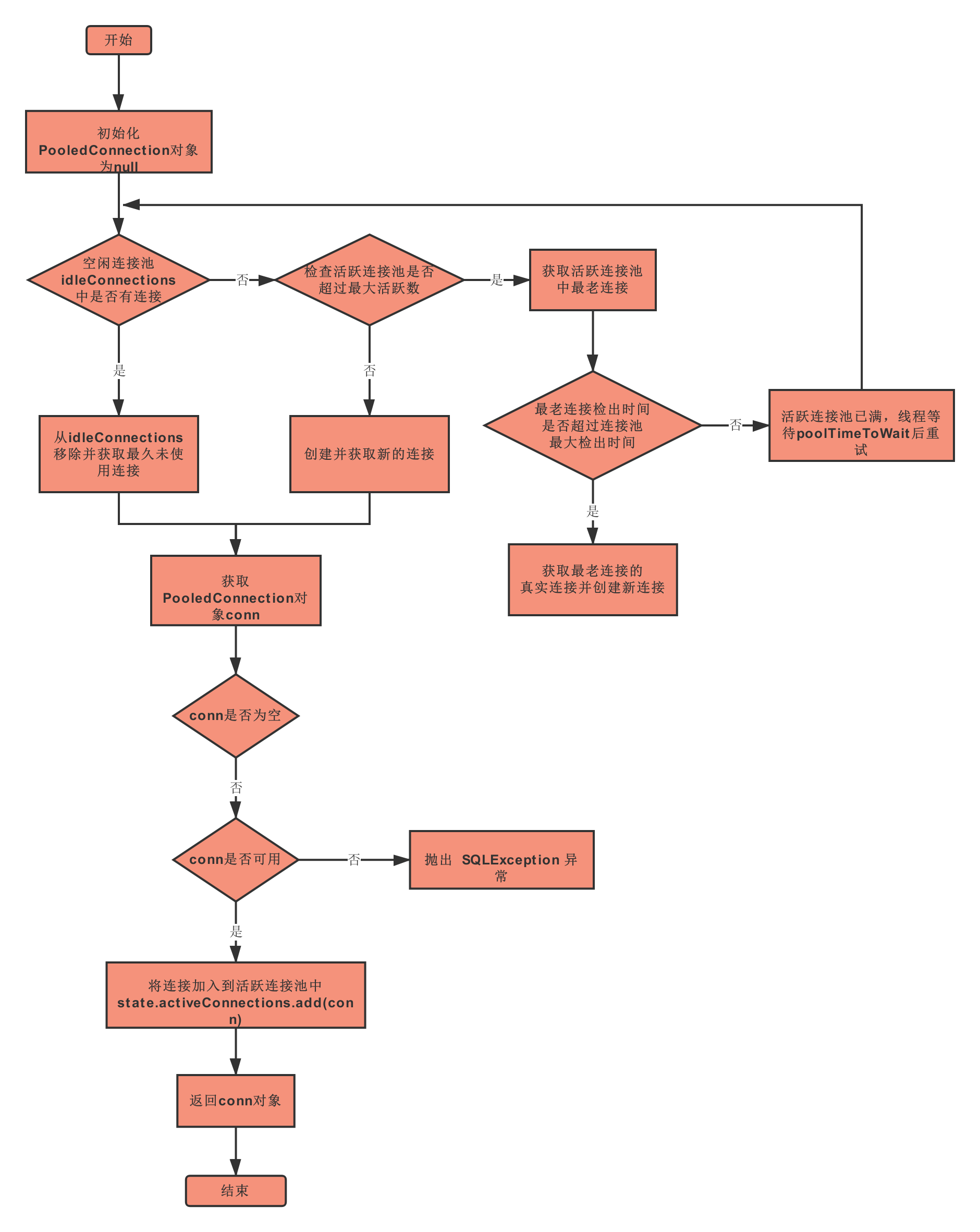Mybatis中的dataSource使用标准的 JDBC 数据源接口来配置 JDBC 连接对象的资源,有三种内建的数据源类型:
- UNPOOLED:这个数据源的实现只是每次被请求时打开和关闭连接。虽然有点慢,但对于在数据库连接可用性方面没有太高要求的简单应用程序来说,是一个很好的选择。 不同的数据库在性能方面的表现也是不一样的,对于某些数据库来说,使用连接池并不重要,这个配置就很适合这种情形。
- POOLED:这个数据源的实现利用“池”的概念将 JDBC 连接对象组织起来,避免了创建新的连接实例时所必需的初始化和认证时间。 这是一种使得并发 Web 应用快速响应请求的流行处理方式。
- JNDI:这个数据源的实现是为了能在如 EJB 或应用服务器这类容器中使用,容器可以集中或在外部配置数据源,然后放置一个 JNDI 上下文的引用。如,我们常在wildfly的standalone.xml 文件中集中配置 JNDI 数据源。

接下来,我们分别看下三种数据源的实现方式。
UnpooledDataSource 数据源创建过程
上文提到,Mybatis 中的 dataSource 使用标准的 JDBC 数据源接口,因此 UnpooledDataSource 是实现了 DataSource 接口的,并重写了 DataSource 中的 getConnection 方法。
看下 UnpooledDataSource 中 getConnection 方法实现:
public Connection getConnection() throws SQLException {
//调用 doGetConnection 获取连接
return doGetConnection(username, password);
}
private Connection doGetConnection(String username, String password) throws SQLException {
Properties props = new Properties();
//获取数据库驱动配置
if (driverProperties != null) {
props.putAll(driverProperties);
}
if (username != null) {
props.setProperty("user", username);
}
if (password != null) {
props.setProperty("password", password);
}
return doGetConnection(props);
}
private Connection doGetConnection(Properties properties) throws SQLException {
//初始化数据库驱动
initializeDriver();
//通过驱动代理类 DriverProxy 对象创建 connection
Connection connection = DriverManager.getConnection(url, properties);
//配置是否自动提交和事务隔离级别
configureConnection(connection);
return connection;
}
UnpooledDataSource 的创建连接过程相对还是简单的。通过以下几步:
- 获取数据库驱动配置。
- 初始化数据库驱动。
- 通过 DriverManager 获取连接。
- 配置连接是否自动提交和事务隔离级别。
PooledDataSource 数据源创建过程
从 PooledDataSource 的代码中可以看出, PooledDataSource 同样继承 DataSource 接口,同时保存了一个 UnpooledDataSource 类的引用,还有一个 PoolState 对象用于保存空闲连接和活跃连接。我们看下获取连接代码:
public Connection getConnection() throws SQLException {
//获取真实连接的代理连接 proxyConnection
return popConnection(dataSource.getUsername(), dataSource.getPassword()).getProxyConnection();
}
private PooledConnection popConnection(String username, String password) throws SQLException {
boolean countedWait = false;
//PooledConnection 是 Connection 真实连接的代理类,用于关闭时特殊处理,下面会分析如何处理关闭情形
PooledConnection conn = null;
long t = System.currentTimeMillis();
int localBadConnectionCount = 0;
while (conn == null) {
//state 是 连接池状态,防止多线程操作,所以加锁
synchronized (state) {
//当空闲池中存在连接时,则从空闲池中取出连接,取列表的一个连接
if (state.idleConnections.size() > 0) {
// Pool has available connection
conn = state.idleConnections.remove(0);
if (log.isDebugEnabled()) {
log.debug("Checked out connection " + conn.getRealHashCode() + " from pool.");
}
} else {
// 当活跃连接池数量小于最大活跃连接池数时,创建新的连接
if (state.activeConnections.size() < poolMaximumActiveConnections) {
// Can create new connection
//这里是用 UnpooledDataSource 对象来创建连接
conn = new PooledConnection(dataSource.getConnection(), this);
@SuppressWarnings("unused")
//used in logging, if enabled
Connection realConn = conn.getRealConnection();
if (log.isDebugEnabled()) {
log.debug("Created connection " + conn.getRealHashCode() + ".");
}
} else {
// 当活跃连接池数量等于最大活跃连接池数时,从活跃连接池的列表取第一个连接
PooledConnection oldestActiveConnection = state.activeConnections.get(0);
long longestCheckoutTime = oldestActiveConnection.getCheckoutTime();
//当池中连接被检出时间大于配置时间(单位毫秒),则重新new一个新连接,并将原连接置为不可用
if (longestCheckoutTime > poolMaximumCheckoutTime) {
// Can claim overdue connection
state.claimedOverdueConnectionCount++;
state.accumulatedCheckoutTimeOfOverdueConnections += longestCheckoutTime;
state.accumulatedCheckoutTime += longestCheckoutTime;
state.activeConnections.remove(oldestActiveConnection);
if (!oldestActiveConnection.getRealConnection().getAutoCommit()) {
oldestActiveConnection.getRealConnection().rollback();
}
conn = new PooledConnection(oldestActiveConnection.getRealConnection(), this);
oldestActiveConnection.invalidate();
if (log.isDebugEnabled()) {
log.debug("Claimed overdue connection " + conn.getRealHashCode() + ".");
}
} else {
//活跃连接池已满,线程等待
// Must wait
try {
if (!countedWait) {
state.hadToWaitCount++;
countedWait = true;
}
if (log.isDebugEnabled()) {
log.debug("Waiting as long as " + poolTimeToWait + " milliseconds for connection.");
}
long wt = System.currentTimeMillis();
state.wait(poolTimeToWait);
state.accumulatedWaitTime += System.currentTimeMillis() - wt;
} catch (InterruptedException e) {
break;
}
}
}
}
if (conn != null) {
if (conn.isValid()) {
if (!conn.getRealConnection().getAutoCommit()) {
conn.getRealConnection().rollback();
}
//设置连接类型编码,取url+username+password 三者拼接字符串的hashcode
conn.setConnectionTypeCode(assembleConnectionTypeCode(dataSource.getUrl(), username, password));
conn.setCheckoutTimestamp(System.currentTimeMillis());
conn.setLastUsedTimestamp(System.currentTimeMillis());
//将连接加入到活跃连接池列表
state.activeConnections.add(conn);
state.requestCount++;
state.accumulatedRequestTime += System.currentTimeMillis() - t;
} else {
//无法获取有效连接
if (log.isDebugEnabled()) {
log.debug("A bad connection (" + conn.getRealHashCode() + ") was returned from the pool, getting another connection.");
}
state.badConnectionCount++;
localBadConnectionCount++;
conn = null;
if (localBadConnectionCount > (poolMaximumIdleConnections + 3)) {
if (log.isDebugEnabled()) {
log.debug("PooledDataSource: Could not get a good connection to the database.");
}
throw new SQLException("PooledDataSource: Could not get a good connection to the database.");
}
}
}
}
}
if (conn == null) {
if (log.isDebugEnabled()) {
log.debug("PooledDataSource: Unknown severe error condition. The connection pool returned a null connection.");
}
throw new SQLException("PooledDataSource: Unknown severe error condition. The connection pool returned a null connection.");
}
return conn;
}
PooledDataSource 的获取连接过程相对复杂一点,可以先看下流程图,简单描述了下上述代码的逻辑过程:

接下来再通过文字描述下上述步骤:
- 首先检查 PoolState 中的空闲连接池 idleConnections 中是否有可用连接。如果有,则直接从空闲连接池中取出一个连接使用。
- 如果空闲连接池 idleConnections 中没有可用连接,那么继续检查 PoolState 中的活跃连接池 activeConnections 是否小于最大活跃连接池数。如果小于,则新建一个连接,新建连接是通过
dataSource.getConnection()建立的,而dataSource是UnpooledDataSource对象,所以PooledDataSource中新建连接是通过UnpooledDataSource对象建立的,通过对象关联避免了重复代码。 - 如果 PoolState 中的活跃连接池 activeConnections 不小于最大活跃连接池数,则从活跃连接池 activeConnections 中取出第一个连接,并检查是否超过连接池最大检出时间 poolMaximumCheckoutTime。如果未超过,则移除第一个活跃连接(最老的活跃连接),并新建一个连接。否则,继续等待获取连接,直到超过最大检出时间 poolMaximumCheckoutTime。
- if (conn != null) 如果连接不为空且可获得,则将获取的连接添加到活跃连接池中。否则,当重试超过一定次数的坏连接后,抛出 SQLException 异常。
接下来,谈另一话题。正常我们执行 SQL 语句,都会在执行前打开连接,执行结束后关闭连接。在 UnpooledDataSource 中确实是关闭了真实连接,那 PooledDataSource 是如何关闭的呢? 刚才说过,PooledDataSource 中 getConnection 返回的是代理连接 proxyConnection,重点就在这个代理类中,它通过代理真实连接对象,并对真实连接对象的调用方法进行了增强。代理类 PooledConnection 使用的是 JDK 动态代理,即实现了 InvocationHandler 接口,并重写了 invoke 方法,我们来看下代理类中是如何处理 PooledDataSource 数据源的关闭操作的。
private static final String CLOSE = "close";
public Object invoke(Object proxy, Method method, Object[] args) throws Throwable {
String methodName = method.getName();
//关键点,当真实连接调用的方法是 close 时,这里是将该连接从活跃连接池移除,并放到空闲连接池中
if (CLOSE.hashCode() == methodName.hashCode() && CLOSE.equals(methodName)) {
dataSource.pushConnection(this);
return null;
} else {
try {
if (!Object.class.equals(method.getDeclaringClass())) {
// issue #579 toString() should never fail
// throw an SQLException instead of a Runtime
checkConnection();
}
return method.invoke(realConnection, args);
} catch (Throwable t) {
throw ExceptionUtil.unwrapThrowable(t);
}
}
}
protected void pushConnection(PooledConnection conn) throws SQLException {
synchronized (state) {
//将连接从活跃连接池移除
state.activeConnections.remove(conn);
if (conn.isValid()) {
//当空闲连接池未达到最大空闲连接池数限制,则将真实连接加入空闲连接池
if (state.idleConnections.size() < poolMaximumIdleConnections && conn.getConnectionTypeCode() == expectedConnectionTypeCode) {
state.accumulatedCheckoutTime += conn.getCheckoutTime();
//检查该连接是否提交,如果未提交,则执行回滚
if (!conn.getRealConnection().getAutoCommit()) {
conn.getRealConnection().rollback();
}
//获取真实连接
PooledConnection newConn = new PooledConnection(conn.getRealConnection(), this);
//添加到空间连接池中
state.idleConnections.add(newConn);
newConn.setCreatedTimestamp(conn.getCreatedTimestamp());
newConn.setLastUsedTimestamp(conn.getLastUsedTimestamp());
conn.invalidate();
if (log.isDebugEnabled()) {
log.debug("Returned connection " + newConn.getRealHashCode() + " to pool.");
}
state.notifyAll();
} else {
//当空闲连接池数超过最大空闲连接池数限制,则将该真实连接关闭
state.accumulatedCheckoutTime += conn.getCheckoutTime();
if (!conn.getRealConnection().getAutoCommit()) {
conn.getRealConnection().rollback();
}
conn.getRealConnection().close();
if (log.isDebugEnabled()) {
log.debug("Closed connection " + conn.getRealHashCode() + ".");
}
conn.invalidate();
}
} else {
if (log.isDebugEnabled()) {
log.debug("A bad connection (" + conn.getRealHashCode() + ") attempted to return to the pool, discarding connection.");
}
state.badConnectionCount++;
}
}
}
从 PooledConnection 代理类中,我们看到了,代理类对连接的 close 方法做了特殊处理:
- 当空闲连接池未达到最大空闲连接池数限制,则将真实连接加入空闲连接池。
- 当空闲连接池数超过最大空闲连接池数限制,则将该真实连接关闭。
这样保证了PooledDataSource数据源中的连接复用,也是Mybatis中连接池的实现机制。
JNDI 数据源创建过程
Mybatis 创建 JNDI 数据源的方式只用到了一个工厂类 JndiDataSourceFactory ,JNDI 数据源创建方式和上面 UNPOOL 和 POOL 方式不同,JNDI 主要是通过启动上下文 InitialContext 和 JNDI 配置文件来完成。InitialContext 是执行命名操作的启动上下文,可以查找到配置文件中的 JNDI 配置:
public void setProperties(Properties properties) {
try {
InitialContext initCtx = null;
//获取 JNDI 配置信息
Properties env = getEnvProperties(properties);
//初始化启动上下文
if (env == null) {
initCtx = new InitialContext();
} else {
initCtx = new InitialContext(env);
}
// 从配置文件中获取 dataSource
if (properties.containsKey(INITIAL_CONTEXT)
&& properties.containsKey(DATA_SOURCE)) {
Context ctx = (Context) initCtx.lookup(properties.getProperty(INITIAL_CONTEXT));
dataSource = (DataSource) ctx.lookup(properties.getProperty(DATA_SOURCE));
} else if (properties.containsKey(DATA_SOURCE)) {
dataSource = (DataSource) initCtx.lookup(properties.getProperty(DATA_SOURCE));
}
} catch (NamingException e) {
throw new DataSourceException("There was an error configuring JndiDataSourceTransactionPool. Cause: " + e, e);
}
JNDI 获取数据源主要分三个步骤:
- 首先获取 JNDI 配置信息。
- 初始化启动上下文 initCtx。
- 上下文调用 lookup 方法获取数据源 dataSource。
Mybatis 中的数据源类型和连接池实现原理就先介绍到这里,以备复习及其他小伙伴学习。





 本文深入探讨MyBatis中三种数据源类型:UNPOOLED、POOLED和JNDI的实现机制,详细分析了各自在数据库连接管理上的特点与优势。
本文深入探讨MyBatis中三种数据源类型:UNPOOLED、POOLED和JNDI的实现机制,详细分析了各自在数据库连接管理上的特点与优势。
















 1220
1220

 被折叠的 条评论
为什么被折叠?
被折叠的 条评论
为什么被折叠?








